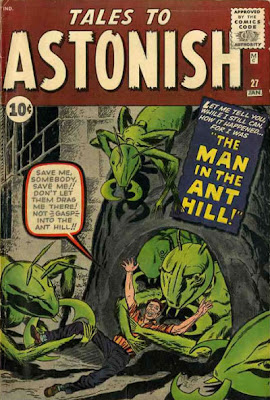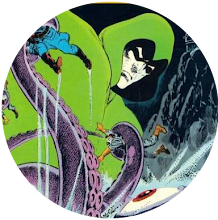It seems like only days ago I was blathering on about it being 1972. And now here I am claiming it's 1962. Clearly a new and strange madness has claimed me.
Fortunately, it's a madness that means I now have a chance to see what our favourite Marvel heroes were up to exactly fifty years ago.
The answer is, "not much," as most of them were still no more than a gleam in the eye of the various people who claim to have created them. But, even that long ago, there were two Marvel comics that brought us the antics of super-powered cavortionists.
It's always seemed a strange cover to me. That window's far too close to the floor. Why's there no furniture? And why does that house have twenty foot high bright yellow walls? But who cares about that? What matters is that Fantastic Four #2 gives us all the Skrulls we could ever need, in the first FF tale I ever read.
Isn't this the story where Reed Richards defeats the would-be invaders by convincing them that comic book panels are photos of real-life monsters that inhabit the Earth - basically using the conceit that, to comic book characters, drawings look like photos? Why, it's positively metafictional before the word was even coined.
It's easy to forget that Marvel's second Silver Age venture into the realms of super-hero-dom featured not the Hulk nor Thor but the mighty Ant-Man.
Of course he wasn't called Ant-Man in that debut tale and had yet to get his costume, let alone the wondrous Wasp but, still, already Henry Pym had gained the power to shrink and be menaced by things that were no kind of threat to anyone else.
I'm sure, from what I can remember, that, at the end of the tale, he vows never again to meddle with such things that man was never meant to meddle with. Oh, Henry Pym, if only you'd known...
Subscribe to:
Post Comments (Atom)





















---01.jpg)



















































8 comments:
Not just the window - look at the door and the pictures on the wall. Clearly a midget lives in that house.
Not only that but the owner likes to hang yellow pictures on a yellow wall, with yellow frames.
Obviously, everything is Skrull-height. You must have missed "Princess Anelle's 30-Minute Makeover".
I can see where George Lucas got the idea for Stormtroopers from. It must of been harder for the Skrull to miss Johnny Storm, standing right over him, than to hit him.
And no ones noticed the vase floating in mid-air.
The Skrull also have the research skills of Ford Prefect. The nice curtains in the window and bare floorboards on the floor. Someone did the research by wandering the streets on evening.
Must HAVE, not must OF, which is not only bad English, but hugely irritating,
I’m glad Aggy pointed out the skrull-stormtrooper similarities—keen observation. I’d really like to see an extensive analysis of the debt Star Wars owes to The Fantastic Four—sort of like what I did with ‘Webs in Lynch’s Closet’ (regarding Blue Velvet's uncanny resemblance to early Amazing Spider-Man) for my Comics Decoder site. People have been muttering about Lucas’s ‘ripoff’ under their breath for years; it would be great to finally see something encompassing and ‘official’ on paper (or screen). Now there’s an idea for a blog entry, Steve....
Actually, this may be as good a time and space as any on this blog to mention an article I’m putting together for the next installment of my aforementioned Comics Decoder site, and possibly solicit some of your opinions and advice.
In my said essay, I propose that the period extending from the mid 1980s to the mid 1990s should be considered a sub-era of—or departure point from—the so-called ‘Modern Age’ of comics. I call this period the ‘Pearl Age’, based on the grounds that: (a) the name reflects a relatively minute yet glittering period in comics history, resembling the jewel in question; (b) it was a period in which new heights of intelligence and sophistication were reached, even in some mainstream titles (‘pearl of wisdom’); and (c) it coincided with the rise (and fall) of grunge/alternative rock, of which Pearl Jam was the most commercially successful.
The major relevant attributes of mainstream comics during this period would consist in the inclusion of more adult-oriented material (e.g., The Watchmen)—sometimes resulting in censorial or even legal difficulties (e.g., Stray Toasters); the rise of artists such as McFarlane, Larsen and Liefield; mega-selling debut and specialty issues, often featuring various covers; the rise of Image Comics; and new television versions of Batman, Flash, Superman, X-Men, Fantastic Four, and Spider-Man. Major relevant attributes of alternative comics would consist in Art Spiegelman’s Pulitzer win for Maus; the increased popularity of the ‘graphic novel’ in general (e.g., Understanding Comics, Like a Velvet Glove Cast in Iron, Why Did Pete Duel Kill Himself?); and the rise of artists such as Bagge, Burns, Clowes, Kalesniko, and Woodring.
Although the proposed Pearl Age runs roughly from the mid ’80s to mid ’90s, the specific start and end points vary from publisher to publisher: Marvel (McFarlane becomes artist on Amazing Spider-Man, 1987—bankruptcy, 1996); Fantagraphics (moves to Seattle, 1989—end of Love & Rockets, 1996); Image (launch, 1992—Liefield leaves, 1996); Drawn & Quarterly (launch, 1991—end of second D & Q anthology series, 1997); DC (The Dark Knight Returns, 1986—?).
I know this blog is dedicated primarily to comics from the silver and bronze ages, but I think the majority of us contributors/subscribers are comics enthusiasts in general. So does anyone have any suggestions or comments? Can anyone recommend a specific cut-off point for DC? Steve? Kid? Anybody?
I'm afraid my knowledge of the period between 1980 and 1990 is extremely vague, as I barely read any comics during that period.
I do know that when I restarted reading comics, in 1991, they felt very different from how they had in the early 1980s, and it has always seemed baffling to me that comics from what's now 20 years ago get lumped in with brand new comics as being from the, "Modern Age," when they seem to me to have changed just as much in the last 20 years as they did in the preceding 20.
Exactly when those eras changed, and how to demarcate them though, I have no idea.
By professing your ignorance, Steve, you've actually said quite a lot about the classification of comics over the past thirty years or so. Like you, I believe this whole idea of lumping the last three decades worth of comics under the banner of 'Modern Age' to be a lazy cop-out. That's why I've elected to do something about it in the form of my essay-in-progress.
Also like you, I abstained from comics for close to a decade: 1981 to 1988--roughly coinciding with my secondary schooling. I lost interest in comics in the early '80s due primarily to companies like Charlton and Gold Key going out of business, and Marvel being turned down on 'Simmer'--the bulk of the '80s was just not the sort of era that Marvel Comics thrive in. As for DC, I was never much of a reader to begin with, and by the early '80s most of their best titles had been cancelled or driven into the muck. Frankly, it was Spider-Man and a feeling that the wind was changing that brought me back to comics in '88.
I'd love to hear what a man-about-comics like 'Kid' has to say about my proposed 'Pearl Age'. I'd appreciate input from virtually anyone, for that matter.
Post a Comment